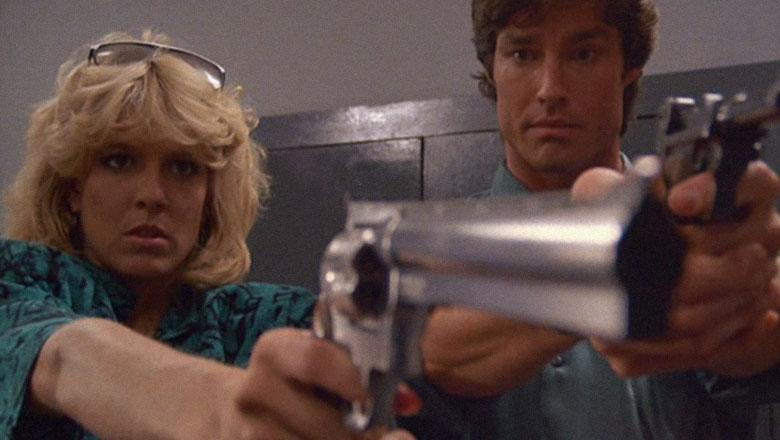If you’ve watched a televised sporting event in the past sixty years, you’re unknowingly familiar what’s known as the “Sidaris style.” The name is taken from one Andy Sidaris, the Chicago-born, Louisiana-raised son of Greek immigrants, who took a part time job at Dallas TV station WFAA-TV while studying at Southern Methodist University in the late 1950s. He quickly found himself in charge of directing the station’s original programming, most notably sports coverage. He revolutionized the visual presentation of sports on television, particularly football, where he was the first to utilize hand-held cameras on the field to bring the audience closer to the action. Foreshadowing his later career, Sidaris also instituted the practice of inserting shots of cheerleaders during lulls in the game.
As sports became a bigger part of national networks’ line-ups in the 1960s, Sidaris was hired by both NBC and ABC to train their staffs in his unique brand of cinematography, and he later joined ABC full time as the first director of their Wide World of Sports program. He remained an innovator of sports coverage for many years, winning Emmys for his direction of everything from college football to the Olympics. Sidaris was both aware and proud of his accomplishments, having contributed an artful aesthetic to heretofore prosaic televised sports coverage, and when a USA Today sports columnist criticized one of his broadcasts, he remarked, “Oh well. One more Emmy and my house would sink into the Pacific anyway.”
Sidaris had an equally large passion for filmmaking. His first foray into the medium was 1969’s The Racing Scene, a documentary on auto racing that featured groundbreaking camerawork but was never widely released due to a dispute between the documentary’s subject, actor James Garner, and the producers. Sidaris would go on to make Stacey! in 1973 and Seven in 1979, neither of which struck a chord with audiences and are simply sketches of ideas seen in his later films. According to Sidaris, the biggest lesson he learned from these first attempts at feature filmmaking was that if he was to be successful, he would need to have complete creative control. So, when he returned to feature filmmaking with Malibu Express in 1985, he did so with much clearer resolve. Malibu Express, like with the next eleven films Sidaris would be involved with, was a unique take on the action genre filled with evidence of his own obsessions, worldview, and sense of morality.
Sidaris’ twelve films of the 1980s and 90s form a single storyline and subvert several conventions of the action genre, most notably the role of women. His atypical depiction of females within the context of action cinema is the most recognizable facet of his work and has lead to them being referred to as “Girls with Guns” films. Apt though it is, there is an implicit dismissal of the films’ artistic merit within this term—it too succinctly distills the films to their barest essence. But the fact that this term oversimplifies Sidaris’ work might also make it the best term to use, however. Sidaris’ work has primarily been judged on a superficial level only, making it fitting to use a term that represents an underestimation of the films’ sophistication and intelligence.
Sidaris himself referred to his films as “Triple B Movies,” a term more descriptive of the content of the films than perhaps any other. Implied by this label is the idea that the films offer up exponentially more of the tropes typically associated with B-movies, in much the same way that it is implied that a XXX film is significantly more explicit than a singular X-rated film. This is not an exaggeration in the case of Sidaris’ films, as they were very much created with an exploitation filmmaker’s mindset to give the audience an abundance of action, adventure and sex. Sidaris’ term has a literal meaning as well, one that describes the formula by which he constructed the films: the three B’s stand for bullets, bombs and babes.
Bullets naturally factor heavily into the Girls with Guns films and gunplay and gunrunning play significant roles in many of the plots. There is another, more important aspect to Sidaris’ use of guns in his films: an obsession with technology and the “new.” In interviews Sidaris admitted to a habit of “constantly going to gun stores to check out various new weapons as they hit the market.” This obsession is most readily seen in his employment of the latest advancements in firearms but also extends beyond that to include vehicles, computers and other gadgetry. Several of the Girls with Guns films see cutting edge – but affordable – technology used as plot points and all of the films incorporate some type of technological exoticism.
Sidaris also frequently hinted at a secondary source for the fascination with gadgetry, the James Bond franchise. In many ways, the Girls with Guns series can be seen as both parody and homage to the James Bond films. Imagine James Bond directed by Russ Meyer, and you’ve got a close approximation of Sidaris’ oeuvre. All of the films are about secret government agents and place a similar emphasis on gadgetry as well as frequent location changes and shadowy multi-national criminal organizations.
As for his second B, explosions occur frequently in Sidaris’ films and are used for both dramatic and comedic effect, often serving as a narrative end to a scene. There are few lulls in Sidaris’ narratives and very few filler scenes. He kept his films moving at a frenetic pace, often juggling multiple plots, characters and locations at once. It is not uncommon in the Girls with Guns series for the film to be simultaneously following three separate teams of agents with as many locations and goals. His elimination of most, if not all, superfluous detail shows that Sidaris was very conscious of his viewership and their expectations of his films.
The final B is the one for which the Girls with Guns films are best known: babes. Sidaris filled his films with Playboy Playmates and Penthouse Pets and marketed them on that basis. Stacey! and Seven each featured beautiful women but employed them in a manner in keeping with the standard for action cinema at the time: eye candy. Beginning with Malibu Express, Sidaris would change the way in which he depicted women. He still cast beautiful women in supporting roles but there was a greater emphasis on their intelligence and resourcefulness. Women not only assist the male hero with his goals, they save his life more than once.
Beginning with Hard Ticket to Hawaii, Sidaris would begin the Girls with Guns series in earnest by using female main characters. Hard Ticket to Hawaii continued Sidaris’ subversion of standard gender roles began in Malibu Express and has the roles of men and women effectively reversed, with women being depicted as strong, resourceful and brave and men as weak, unintelligent and cowardly. Hard Ticket represents a decisive break with the typical depictions of women in action cinema. Sidaris’ women are neither damsels-in-distress dependent on men to rescue them nor femme fatales preying on men through their sexual charms. Their strength is depicted as neither feminine nor masculine, simply human.
Sidaris’ intent to glorify the women’s abilities without tying them to a specific gender identity is evident through his choice of language. His heroines are never referred to as the best “female agents” but simply the “best agents.” His male villains never mention that their opponents are female. Gender is a non-issue for the characters in the Girls with Guns series; a vast departure from the majority of films where the achievements of heroines are marginalized, if shown at all. Sidaris’ subversion of gender roles is too pervasive to have been accidental and its uniqueness warrants further analysis.
Sidaris’ most memorable contributions to cinema, Hard Ticket to Hawaii and Picasso Trigger, will be shown as part of our series at 92Y Tribeca on August 10, 2012.
Reviews
We don’t do comments anymore, but you may contact us here or find us on Twitter or Facebook.





